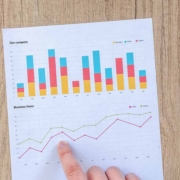How to Avoid Carrying Cost Mistakes in Inventory Optimization
Inventory optimization has two significant components: acquisition cost and carrying cost. If either of these factors is inaccurate, you could be leaving money on the table. An accurate carrying cost calculation can be the difference between a highly profitable inventory optimization program and one that forces you to close your doors.
Carrying Cost Mistakes: Inventory Optimization Killers
So, you’ve implemented a highly successful PO tracking program, and you know your acquisition cost for each product and location down to the cent (kudos if you’ve read our blog on acquisition cost). Now what?
While many top retailers (or grocers or wholesalers) may include many factors in their carrying cost calculations, we’ve found that most businesses overly simplify their projections, losing valuable margins. We’ve also found out that calculations often leave out real-world restrictions, including:
- Warehouse Space: While an Order Cycle of 90 days might be optimal from a math perspective, do you have the warehouse conduits to receive 18 tractor-trailers on the same day?
Warehouse Fullness: How full is your Warehouse? If it is more than 90% full, additional inventory may inhibit day-to-day warehouse function. Beware.
DC to Store Shipment Days: A 10-day order cycle is useless if you can only ship to your stores every seven days. Be aware of this when calculating an optimal carrying cost.
DC Processing Time: If shipping from DC to store or to sub-DC, you must also calculate a DC Processing Time. DC Processing Days are the average number of days between the receipt date and the ship-out date (or date available for pick). Accordingly, DC Processing Days is a critical number across your business. Does your system even track DC processing time?
Have you avoided these pitfalls? Read on and “Tighten the Links in your Chain™.”
Carrying Cost Tips: Profit Makers
Inventory optimization is just a math problem (albeit a complex one). Our advice is simple: abstract out and simplify your cost calculations to come up with a reasonable approximation of your actual carrying cost.
There are a series of passive costs that increase with time. The longer the product sits in a warehouse, the more these quantifiable costs increase. Those include:
- Depreciation
- Building Storage
- Taxes
- Employee Cost
- Insurance
- Risk of Shrink (Theft)
- Risk of Damage in the Warehouse (physical, water, fire, etc.)
NOTE: Do you sell perishable goods? If so, calculating an accurate demand forecast will be critical to avoiding product spoilage.
We’ve saved the most important tip for last.
Cost of Money: The Carrying Cost Driving Factor
The cost of money is essentially an opportunity cost, and it’s what you use to gauge the real-world impact of cash tied up in stale inventory. Have you leveraged your assets to acquire inventory? Inventory that doesn’t move, or inventory that moves slowly, can put you out of business. Even if you’ve paid for your inventory in cash, dollars spent on product X are dollars that the merchant cannot spend on product Y.
Calculating Cost of Money for Inventory Optimization: It’s Complicated
Calculating an accurate cost-of-money percentage is complicated. We provide a custom cost-of-money percentage for our customers’ inventory optimization needs. Different industries (even different segments or departments of the same sector) often require different percentages. We encourage you to discuss and review your inventory carrying costs semi-annually, at minimum, to identify opportunities for additional profit.
Closing
We strive to give our customers every possible advantage in this low-margin market. Effective inventory optimization can add full percentage points to your bottom line. Want to learn more? Request a demo, and we’ll show you how it works at Data Profits.
- Demand Forecasting: The Ultimate Secret for Your Organization’s Success - August 7, 2024
- How to Avoid Carrying Cost Mistakes in Inventory Optimization - June 10, 2024
- 3 Common Forecasting Software Issues and How to Fix - May 20, 2024










